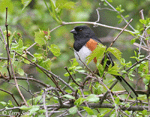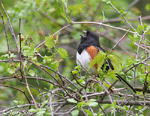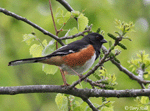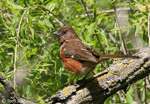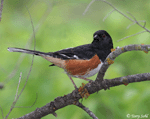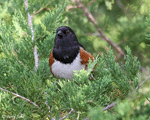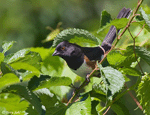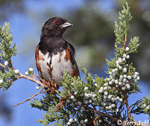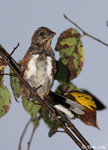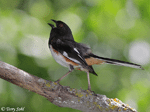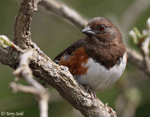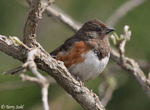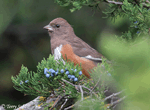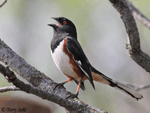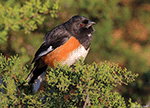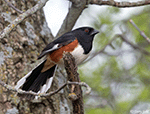| Length: 7.5 inches | Wingspan: 10.5 inches | Seasonality: Summer / Migrant |
| ID Keys: Black upperparts and hood, rufous sides, white underparts, red eye. Note lack of white spots that are seen on the very similar Spotted Towhee. | ||
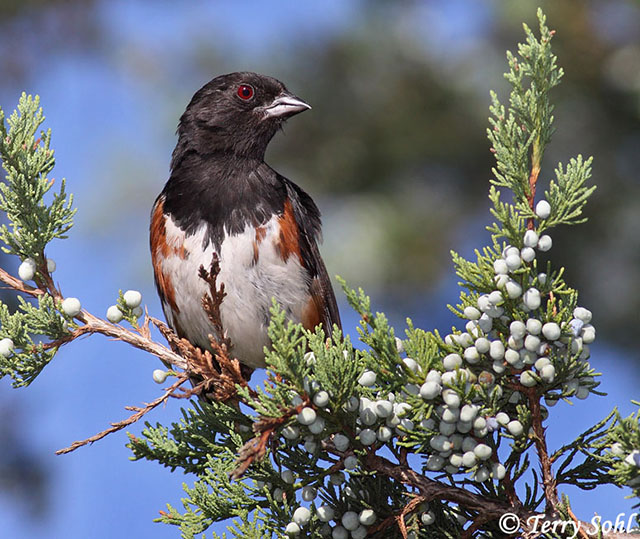 The Eastern Towhee and the Spotted Towhee were formerly
considered separate races of the same species, the Rufous-Sided Towhee (a name
which is no longer used). The two are very similar, but differ in range,
as the Spotted Towhee is mostly a western U.S. bird while the Eastern Towhee is
an eastern U.S. bird. The Eastern Towhee also lacks the Spotted Towhee's
white spots on its back and wings. The two species may interbreed where
their ranges overlap (including in South Dakota).
The Eastern Towhee and the Spotted Towhee were formerly
considered separate races of the same species, the Rufous-Sided Towhee (a name
which is no longer used). The two are very similar, but differ in range,
as the Spotted Towhee is mostly a western U.S. bird while the Eastern Towhee is
an eastern U.S. bird. The Eastern Towhee also lacks the Spotted Towhee's
white spots on its back and wings. The two species may interbreed where
their ranges overlap (including in South Dakota).
Habitat:
Prefers brush and thickets, usually as the understory to a forest/woodland, in second-growth forest after forest clearing, or along forest edges. They often prefer areas with a heavy cover of leaf litter, their preferred areas for foraging.
Diet:
Insects, fruits and berries, seeds, nuts, occasionally small reptiles, amphibians, and snakes.
Behavior:
Eastern Towhees prefer to forage on the ground, scratching through leaf litter for food. They will also clamber through shrubs and trees in search of food.
Nesting:
June and July. The nest of an Eastern Towhee is a cup, constructed by the female and made of sticks, bark, leaves, and grasses, and lined with finer grasses or hair. It is usually placed on the ground in a protected location, such as under a bush or next to some other clump of vegetation. They will also occasionally nest in a low bush, rarely over 3 feet from the ground. The female lays between two and six eggs, and she alone incubates them. The young hatch after about 12 days, and fledge from the nest in another 10 or 12 days. In favorable conditions Eastern Towhees will raise more than one brood in a summer.
Song:
The classic song of an Eastern Towhee is most often described as a "Drink your Tea!". The typical call is a risking, chewEEEE note.
- Click here to hear a singing male Eastern Towhee1
- Click here to hear the call of an Eastern Towhee2
Migration:
Northern populations (including those in South Dakota) migrate south in the fall. Eastern Towhees overwinter in the southeastern part of the United States, but will sometimes overwinter as far north as the Mid-Atlantic or southern Corn Belt.
Interactive eBird Map:
Click here to access an interactive eBird map of Eastern Towhee sightings
Similar Species:
Spotted Towhee. The Eastern Towhee is the species found in the eastern US, while the Spotted Towhee is found in the West. Many sites say there's little to no overlap in range, but alas, South Dakota is one area where they can sometimes be found side-by-side. In an area such as Newton Hills State Park, both species can be found, but Eastern Towhees are the much more common of the two species. Visually, the two are virtually identical, except for the spotting on the wings of the Spotted Towhee. Songs are typically different as well, but in the area they overlap, the two species can sometimes interbreed, and sometimes copy bits of each other's song. At Newton Hills, I have personally come across birds that look like Eastern Towhees, but are singing more like a Spotted Towhee.
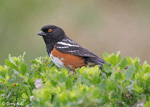 |
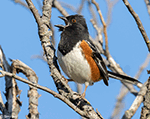 |
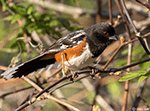 |
| Spotted Towhee | Spotted Towhee | Spotted Towhee |
Bird Feeders:
Will attend feeders for suet and some seeds.
Conservation Status:
Has declined in the northeastern U.S. and locally elsewhere, usually due to habitat loss. However, they are still found over a very broad geographic area, have strong populations overall, and are common in many parts of their range. The IUCN lists the Eastern Towhee as a species of "Least Concern".
South Dakota "Hotspot":
Newton Hills State Park in Lincoln County usually is very reliable for finding Eastern Towhees in the summer months. Look through the brush along Sergeant Creek, near the horse and camping area on the northeastern side of the park. It is one place where you do have to also be on the lookout for their close cousin, the Spotted Towhee. In my part of the state I can also find them pretty easily at the Big Sioux Recreation Area and the Beaver Creek Nature Area near Brandon.
Further Information:
- USGS Patuxent Bird Identification InfoCenter, Eastern Towhee
- WhatBird - Eastern Towhee
- Audubon Guide - Eastern Towhee
Photo Information:
August 28th, 2009 - Newton Hills State Park, South Dakota - Terry Sohl
AAdditional Photos:
Click on the image chips or text links below for additional, higher-resolution Eastern Towhee photos.
Audio File Credits:
- 1Greg Irving. Recorded in Sherburne, Minnesota on July 28th, 2018. Original recording and information available from xeno-canto.
- 2Peter Boesman. Recorded in Chincoteague National Wildlife Refuge in Virginia on October 23rd, 2017. Original recording and information available from xeno-canto.
| Click on the map below for a higher-resolution view |
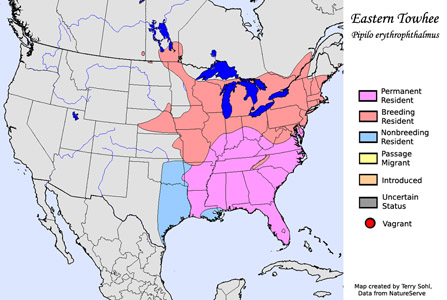 |
| South Dakota Status: Uncommon migrant in the eastern half of the state. Uncommon summer breeder in the southeastern corner of the state |
Additional Eastern Towhee Photos
Click for a higher-resolution version of these photos
